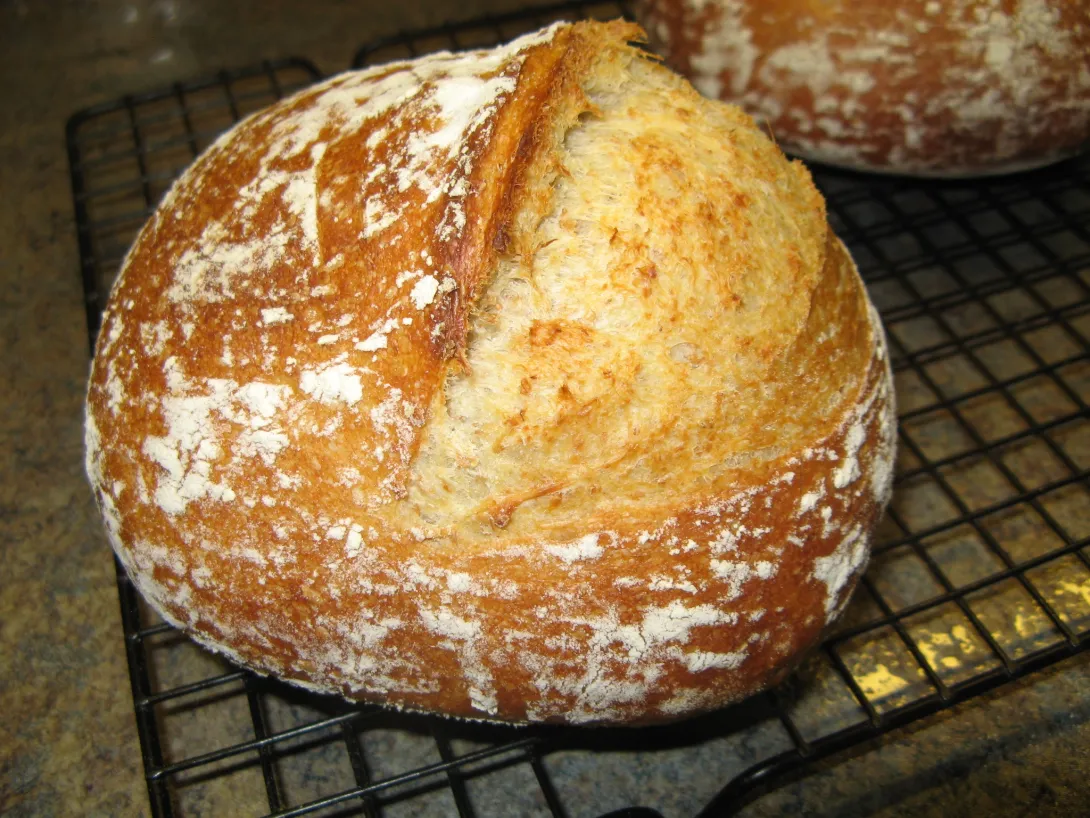
I'll be teaching my first Artisan Bread Basics class on Sunday. Just a couple of friends here in my kitchen, but I wanted to be well-prepared so they can have a good experience and learn some useful things. I'll be running this class a few times with people who are at different levels of experience with bread making, so I need to also pitch it a little differently depending on attendees.
One of the key things I want to focus on is hydration - what it means and how it affects both the handling of the dough and the finished product. I settled on Forkish's Harvest Bread with Poolish as the test loaf for them to learn to bake this kind of bread (baked on stones; how to handle it, etc.). I made up three different recipe cards for the Harvest bread with only one change - the hydration level. So I've got formulas for 67% hydration, 72% hydration and 75% hydration (astute readers will notice that the original recipe has 78% hydration - not going there for a basics course!).
I figured I should test this out before the students get here so yesterday I baked three half-sized (325 grams wet dough weight) loaves, one of each hydration. They all used the same poolish pre-ferment and flour blend, and differed only in the percentages of each ingredient to give the target hydration level. I handled them all the same - mix by hand, stretch & fold, bulk ferment, pre-shape, shape, proof and bake. There may have been small differences in the length of the bulk ferment as I mixed the doughs one after the other (so the first one fermented a bit longer than the last). However, final proof times were almost the same.
As expected, the higher hydration doughs were softer, stickier and easier to stretch. All had a wonderful windowpane at the last stretch and fold (total of three) and formed nice smooth dough balls. The lower hydration was easier to shape (good for the newbies) but all were reasonable at this stage and went into the baskets with no problem.
On the peels, the higher hydration loaf spread a little but not much (possibly partly due to the small loaf size). I scored them differently to make sure I knew which one was which - one score for the 67%, two for the 72% and three for the 75%
Once baked, here's where the startling results came in. The 67% hydration loaf had significantly more oven spring than the other two. In fact, the 75% hydration loaf scores hardly opened at all! Could it have proofed that much more quickly?
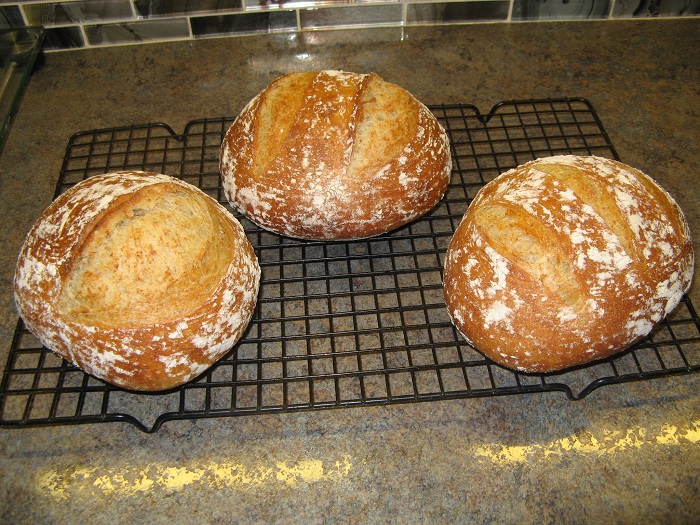
In order from left to right - 67%, 72% and 75%
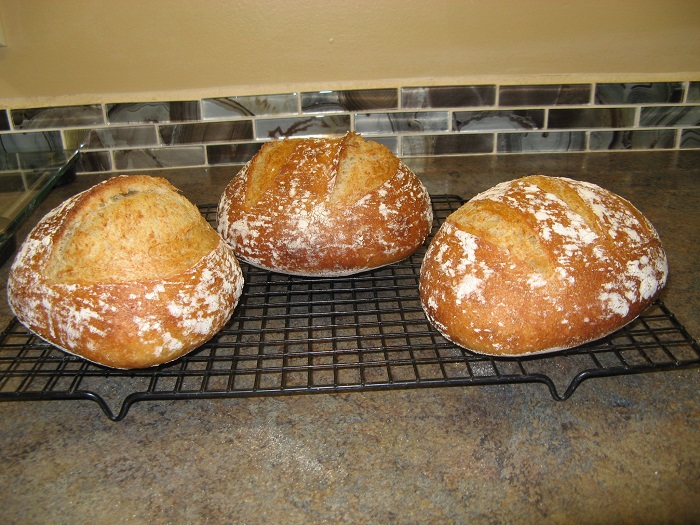
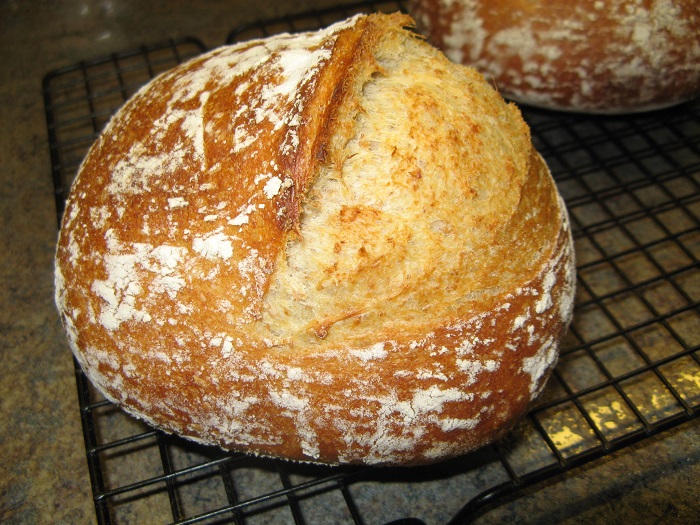
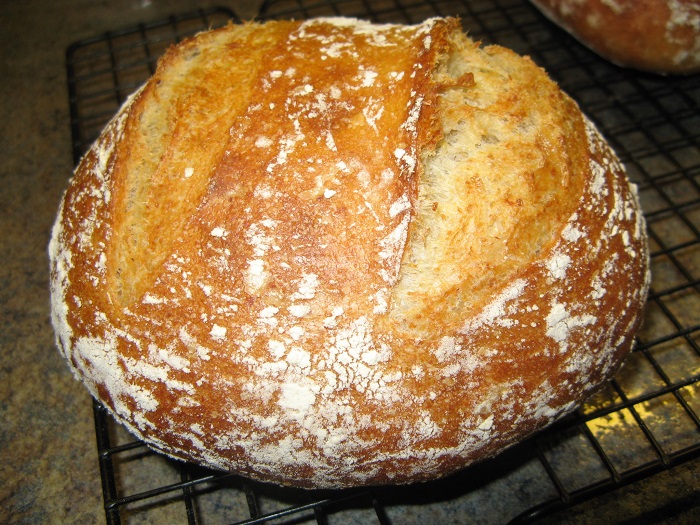
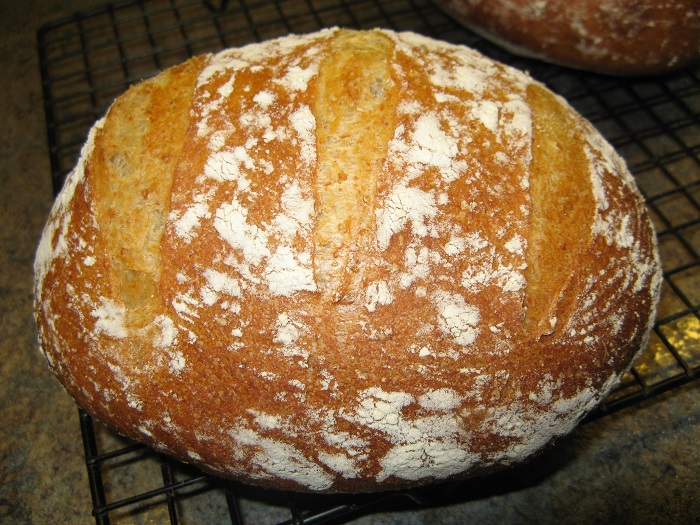
After cooling, I cut them all in half to examine the crumb. Another surprise - they were almost identical. The 67% hydration may have been a tiny bit less moist, but seemed more open. The mouse holes were probably a result of sloppy shaping on my part (didn't degas properly) but I don't think they contributed greatly to the increased oven spring on this loaf.
67%:
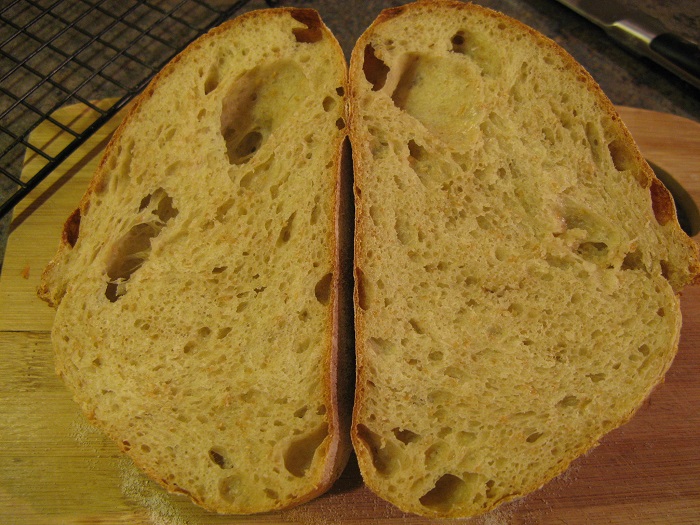
72%:
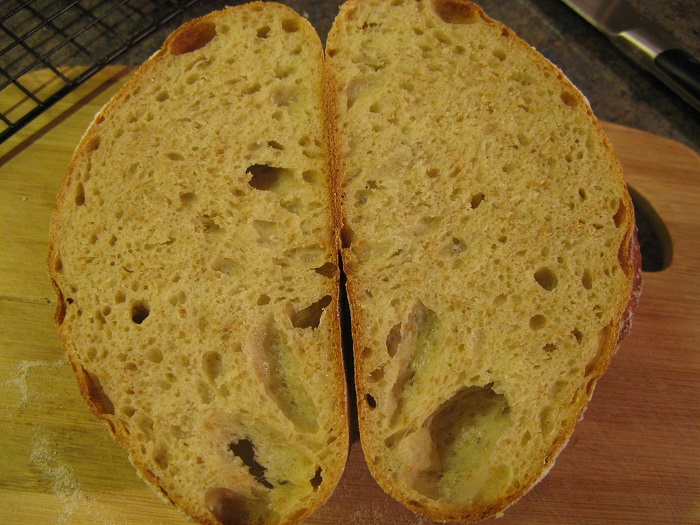
75%:
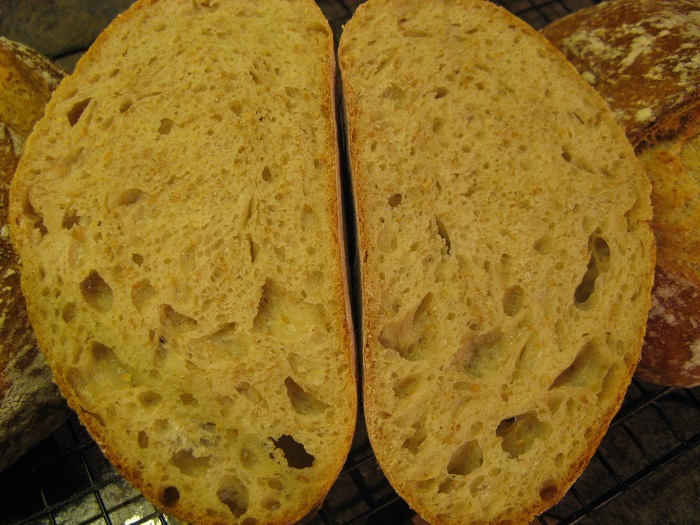
The thing I take away from this experiment is that maybe pushing ourselves to higher hydration doughs doesn't necessarily result in better bread! I guess it depends whether you bake for yourself or others, how much you bake (make it easier on yourself by lowering the hydration a bit) and whether you are focusing on increased skill development or better bread results! Personally, I'm happy with all of these and feel less guilty about lowering the hydration of FWSY and Tartine breads. :)
For sharing your results.
All the best with your class!
I suppose those who like the big holes find it easier to get them with higher hydration. Too, baguettes and braided loaves might benefit from wetter dough due to the greater extensibility. I've found that how I handle the dough more important than hydration, within limits.
I've read that greedy bakers added extra water to get weight without added expense.
Regarding spring, perhaps the more slashes, the less each is affected? Try again, maybe, with the slashing counts different.
g
Full disclosure: I seldom bake a lean bread or a style that favors large holes, favoring an enriched sandwich loaf. :shrug:
thanks for sharing. They all look delicious!!!
hester
I think that the "less oven spring" on the 75% loaf is probably two things... I think that because it spread a little on the peel, the spring suffered a touch. You can kind of tell in the pictures that it looks like the lower hydration loaf seemed to hold its shape. It just seems like the lower hydration loaf has a smaller circumference compared to the higher hydration loaf. Also, the fact that you had 3 scores compared to 1... that may make a difference as well. The spring will be very similar in both, but it would appear that the 1 score opens much more because... well there's only 1 score for the loaf to rise through.. Comparing that to 3 scores. There are more openings where the loaf can rise up through, making it appear that it doesn't open as much.
Not sure if that makes sense or not, that is me trying to put my rambling thoughts in to writing haha! either way, All 3 look amazing and the class will be great fun I am sure! Good Luck!
Did the three loaves all go into the oven simultaneously? Did one get a better steam bath than the others did (or, the other way around, did one get less benefit of steam than the others)? I often have loaves that seem to have sagged a bit coming out of the banneton, but the oven spring is still surprising. I wonder if the presence of steam is one factor. Also, if the loaves went into the oven in succession, then the loss of heat as the door was opened each time might have made a difference too.
Just some thoughts. I agree with the other comments that these look like great loaves. Thanks for posting your experiment.
Yes, steam for all three. They all went into the oven simultaneously, on the same peel, and were rotated halfway through the bake to adjust for hot spots.
I get what people are saying about the 'one score versus three scores'. However, the higher hydration loaf was significantly 'shorter' than the 67% loaf, while not being much smaller around. None of the loaves spread much on the peel or the baking stone because they were quite small and all were good, strong, well-developed dough. That said, I find often in my baking that a single score works best and definitely gets the best ears on most loaves!
It follows with what I have been casually observing in my own baking... that lower hydration loaves usually get better oven spring. And they are much easier to handle so it is a winning combo for me.
teaching!
I have been really noticing that my dough-handling skills are much better suited to lower hydration, and to smaller loaves (I'm learning to keep them down to under 900g). I also am far better at judging fermentation and proofing with the lower hydration dough, since the wet stuff always is a bit more slack and there just isn't the obvious difference when it is starting to relax. Being able to get a tighter shape and hit the proofing time is consistently giving me better oven-spring and overall better crumb texture.
I'm starting to think that the "higher hydration = more open crumb" might be more true at the higher levels (at least 80%), and is really dependent on the baker having the handling skills, or it being a type of bread requiring very little handling (such as ciabatta).
I don't have the skills, so I end up with flatter, wider loaves when I go too high on the hydration, with a light enough crumb but certainly not what it "should" be. I also end up as a cranky and frustrated baker because it feels more like trying to wrangle an uncooperative amoeba than it feels like shaping dough (and I'm not a good amoeba-wrangler).
I sure wish I was closer - I'd be attending your class in a heartbeat! Not only will they be getting valuable skills, they're sure to have a great time, too.
Looking forward to hearing how it went!
Best, Laurie
Hahaha - "trying to wrangle an uncooperative amoeba"! That set me laughing for sure; it's so accurate! I remember years ago a professor telling me that trying to get her students to learn something (can't remember what it was) was like trying to nail currant jelly to the wall. That one still makes me laugh. :)
We'll be shaping and baking ciabatta buns for lunch on class day, so they will get a touch of handling 80% hydration white dough too. That should be really fun!
would love to get together with others - it would be so much fun, you would learn sooo much... guess I am just a little bit toooo far away :(
I was reading an article from Trevor Wilson in a link Laurie put in another post about shaping. I think I am still winging it... so much to learn still. thanks everyone for all the tips that pop up in all the different posts. Just wish we weren't all scattered across the globe!
it was a great experiment, crumb an all.
happy baking
Leslie
Wouldn't that be great, to get a bunch of us together to bake and talk. What do you thing @FloydM? Unfortunately I probably couldn't afford to attend unless it was in Victoria or Vancouver (Canada) but what a good time we would all have, I'm sure. You folks on this site are like very good friends even though I've only actually met one Fresh Loafian in person!
I have now met two (well three, sort of, MichaelLily’s brother) and it was amazing both times! I would love a Fresh Loaf meet up!
They are usually more local in nature, which makes it easy for people in the (fill in the blank) area to attend without incurring travel costs. All thoroughly ad hoc, of course. For instance, Postal Grunt and I arranged one some years back for folks living in the vicinity of Kansas City. Hmm, might have to do that again.
Anyway, just put out the word here on TFL to see if there are some folks in your area that would like to meet. If there is enough interest, arrange the place and time and have fun.
Paul
no matter what our mothers told us!
I'm over the desire for big holes in my bread. Been there, and mostly done that. So I also like your lower hydration boule, even if for only the size of the grigne. And for beginners, if the dough isn't too rubbery and resistant, why not give them something that they can easily handle. We all know the frustration of trying a too high hydration dough too early in our "careers".
Have fun with the class. I've done it a very few times, but only with 1 or 2 folks at a time.